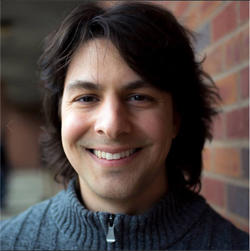
Justin Lines
PhD Thesis:
Cortical Astrocyte-Neuron Network Interaction in Health and Disease
Undergraduate Institution and Major:
The Ohio State University, BS, Physics, 2008
University of Arizona, BS, Applied Mathematics, 2012
Current Position:
Postdoctoral Fellow, Columbia University
Graduate Advisor:
Alfonso Araque, Ph.D., Department of Neuroscience
Description of Graduate Research:
Cortical activity is believed to be exclusively mediated by neurons; however astrocytes are emerging as important cells in brain function because they bidirectionally communicate with neurons. Dysregulation of this interaction may contribute to pathophysiology in neurodegenerative diseases such as Alzheimer’s disease. Using multiphoton calcium fluorescence imaging simultaneously with electrophysiology in vivo, I aim to define astrocyte cortical activity, its impact on neuronal network function, and beta-amyloid induced astrocyte-neuron dysfunction in Alzheimer’s disease.
Publications:
- Lines J, Baraibar AM, Fang C, Martin ED, Aguilar J, Lee MK, Araque A, Kofuji P. Astrocyte-neuronal network interplay is disrupted in Alzheimer's disease mice. Glia. 2022;70(2):368-378.
- Lines J, Martin ED, Kofuji P, Aguilar J, Araque A. Astrocytes modulate sensory-evoked neuronal network activity. Nat Commun. 2020;11(1):3689.
- Torres Jimenez N, Lines JW, Kueppers RB, Kofuji P, Wei H, Rankila A, Coyle JT, Miller RF, McLoon LK. Electroretinographic abnormalities and sex differences detected with mesopic adaptation in a mouse model of schizophrenia: a and b wave analysis. Invest Ophthalmol Vis Sci. 2020 Feb 7;61(2):16.
- Corkrum M, Covelo A, Lines J, Bellocchio L, Pisansky M, Loke K, Quintana R, Rothwell PE, Lujan R, Marsicano G, Martin ED. Thomas MJ, Kofuji P, Araque A. Dopamine-evoked synaptic regulation in the nucleus accumbens requires astrocyte activity. Neuron. 2020;105(6):1036-1047.
- Durkee CA, Covelo A, Lines J, Kofuji P, Aguilar J, Araque A. Gi/o protein-coupled receptors inhibit neurons but activate astrocytes and stimulate gliotransmission. Glia. 2019 Jun;67(6):1076-1093.
- Lines J, Covelo A, Gómez R, Liu L, Araque A. Synapse-specific regulation revealed at single synapses Is concealed when recording multiple synapses. Front Cell Neurosci. 2017 Nov 23;11:367.
- Lines J, Nation K, Fellous JM. Dorsoventral and proximodistal hippocampal processing account for the influences of sleep and context on memory (re)consolidation: A connectionist model. Comput Intell Neurosci. 2017;2017:8091780.
Oral Presentations:
- Synapse Specific Regulation is Revealed at Single Synapses, Graduate Program in Neuroscience Colloquium Series, 2018, Minneapolis, MN
- In Vivo Imaging of Sensory Evoked Astrocyte Activity, Graduate Program in Neuroscience Colloquium Series, 2017, Minneapolis, MN
- Astral-Neural Networks are Coordinated During Rhythmic Local Field Potential Activity, International Astrocyte School, 2016, Bertinoro, Italy
- Using Noise to Reconsolidate Memories during Sleep: A Connectionist Model, Sleep rhythms and memory reconsolidation workshop, CNS 2014, Quebec City, Quebec.
Conference Presentations (Posters):
- Lines J, Covelo A, Gomez R, Liu L, Araque A. Synapse-specific regulation revealed at single synapses is concealed when recording multiple synapses. Society for Neuroscience; November 2018; San Diego, CA.
- Araque A, Aguilar J, Lines J. Sensory evoked cortical astrocyte activity in vivo. Spanish Society for Neuroscience; September 2017; Alicante, Spain.
- Lines J, Rai A, Araque A. In vivo Imaging of sensory evoked astrocyte activity. Wallin Neuroscience Discovery Day; February 2017; Minneapolis, MN.
- Lines J, Nation K, Fellous JM A connectionist model of context-based memory reconsolidation in the hippocampus: the role of sleep. BMC Neuroscience 2014, 15(Suppl 1):P163 (21 July 2014) (Peer reviewed)
Awards and Honors:
- Sping and Ying Ngoh Lin Award, University of Minnesota, 2018
- F31 Ruth L. Kirschstein National Research Service Award AG057155, NIA, 2018-2020
- Doctoral Dissertation Fellowship, University of Minnesota, 2018
- Travel award to attend MMBioS Computational Cell Modeling Workshop at the Allen Institute in Seattle, WA, 2018
- Stark Award for Academic Scholarship, University of Minnesota, 2016
- T32 Fellowship, Graduate Program in Neuroscience NIH Predoctoral Training Grant, University of Minnesota, 2015-2106
- Travel Award to attend CNS 2014 in Quebec City, Organization for Computational Neuroscience, 2014
- College of Science Staff Advisory Council Professional Development Grant, University of Arizona, 2014
- Honorable Mention, University of Arizona, 2011, 2012
Graduate Program in Neuroscience Committees:
- GPN Curriculum and Exams Committee 2016-2018
- Improving Student Success Committee 2017-2018
Professional Societies:
- American Association for the Advancement of Science
- Society for Neuroscience
- Organization of Computational Neuroscience
Thesis Committee Members:
- Eric Newman, Ph.D., Department of Neuroscience (Chair)
- Alfonso Araque, Ph.D., Department of Neuroscience
- Geoffrey Ghose, Ph.D., Department of Neuroscience
- Esther Krook-Magnuson, Ph.D., Department of Neuroscience
Research Categories:
- Neuroimaging & Optogenetics
- Synaptic Plasticity & Learning
Rotations:
- Cheryl Olman, Ph.D., Department of Psychology
- A. David Redish, Ph.D., Department of Neuroscience
- Alfonso Araque, Ph.D., Department of Neuroscience
- Eric Newman, Ph.D., Department of Neuroscience
Why Did You Choose MN?
I chose the U of MN because of all of the great research groups, strong collaborative feel, and state of the art equipment and facilities.
Student Mentor and the Best Advice They Gave.
Nathalia Torres Jimenez: She provided me with a general idea of the academic landscape within the University to better select rotations, what places to look for apartments when I moved into the Twin Cities, and any and all questions about classes and grad school life.
